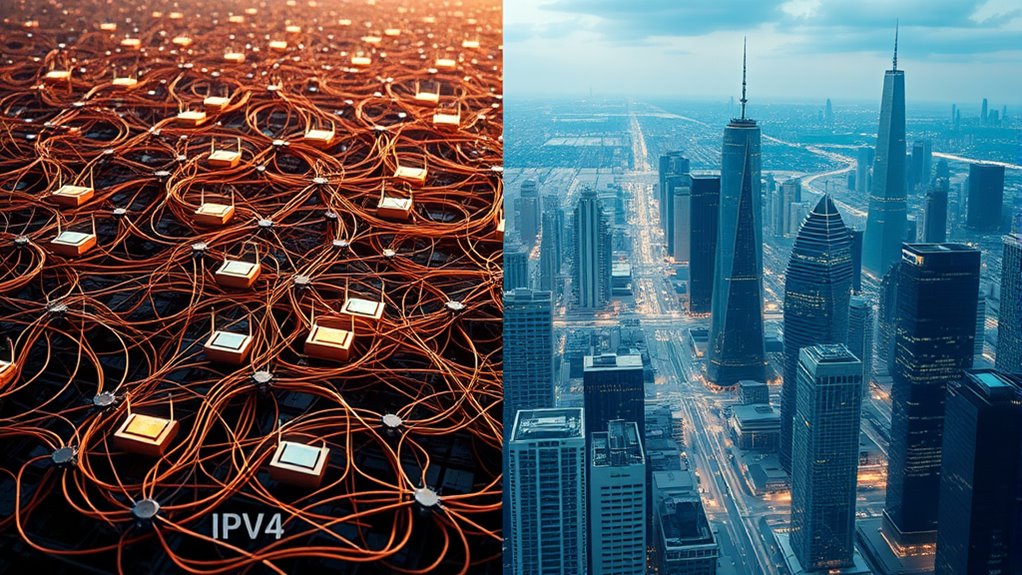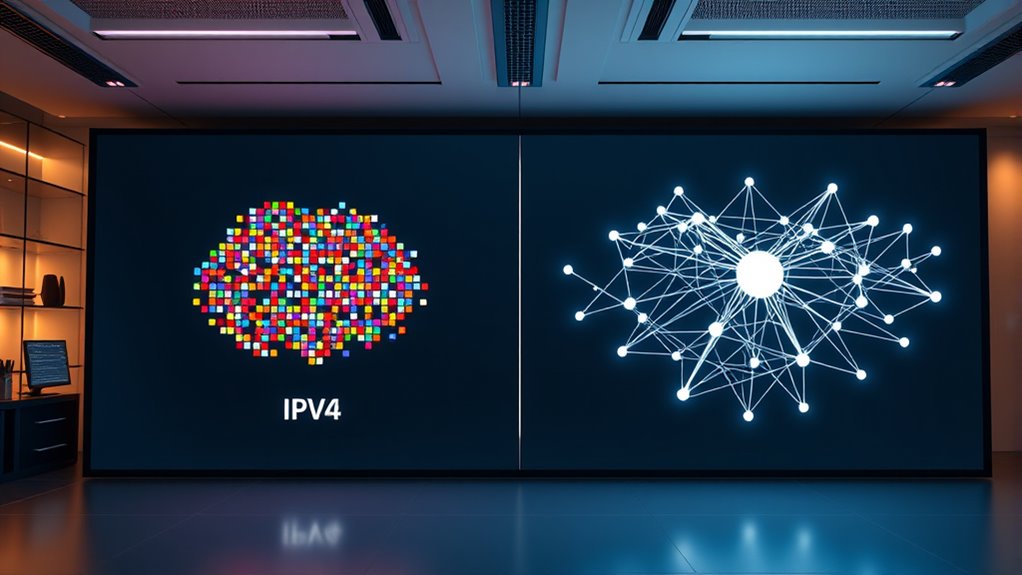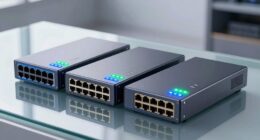IPv4 and IPv6 are two internet protocols. IPv4 is the older system, providing about 4.3 billion addresses, which is running out due to the explosion of connected devices. IPv6 offers a huge address space, over 340 undecillion addresses, making it ideal for future growth. It also improves security and simplifies network setup by reducing reliance on NAT. To understand their differences and how they work together, keep exploring these advanced networking concepts.
Key Takeaways
- IPv4 has about 4.3 billion addresses, while IPv6 offers over 340 undecillion addresses, solving address exhaustion.
- IPv4 often uses NAT to conserve addresses, but IPv6 eliminates the need for NAT with its vast address space.
- IPv4 can complicate peer-to-peer connections, whereas IPv6 supports direct communication more easily.
- IPv4 security features like IPsec are optional, but IPv6 includes mandatory IPsec support for better security.
- IPv4 and IPv6 are incompatible, requiring dual-stack support during transition to ensure compatibility.

As the internet continues to grow rapidly, the need for more unique IP addresses becomes increasingly critical. IPv4, the older version of Internet Protocol, was initially designed with about 4.3 billion addresses. At the time, that seemed more than enough. But as more devices connect to the internet—smartphones, IoT gadgets, servers—those addresses started running out. To manage this limitation, techniques like network address translation (NAT) became common. NAT allows multiple devices within a private network to share a single public IPv4 address, conserving address space and providing a layer of security. However, NAT complicates peer-to-peer communication and can hinder certain applications, which is a significant drawback.
Enter IPv6. This newer protocol was developed precisely to address IPv4’s limitations, offering a vastly expanded address space—more than 340 undecillion addresses. With IPv6, each device can have its own unique address, eliminating the need for NAT in most cases. This shift simplifies network configurations and enhances end-to-end connectivity. Plus, IPv6 includes features that improve internet protocol security, such as mandatory support for IPsec, which encrypts data packets to protect against eavesdropping and tampering. Because IPv6 was built with security in mind, it offers a more robust foundation for secure communications compared to IPv4, where IPsec support was optional and often not implemented. Additionally, the high scalability of IPv6 ensures that future growth of connected devices can be accommodated without address exhaustion.
While IPv4 and IPv6 are incompatible directly, the *changeover* is underway. Many networks use dual-stack configurations, where devices support both protocols, enabling seamless communication during the migration period. This dual support helps maintain compatibility while gradually *shifting* to the more scalable and secure IPv6. Over time, as more devices and networks adopt IPv6, the reliance on NAT will decrease, and internet protocol security will become more streamlined and integral to everyday communications.
Frequently Asked Questions
How Does IPV6 Improve Internet Security Compared to IPV4?
IPv6 improves internet security by offering encryption enhancements and privacy features that IPv4 lacks. You benefit from built-in IPsec, which ensures data encryption and authentication, making your online activities more secure. Additionally, IPv6 has privacy extensions that help conceal your real IP address, protecting your identity. These features make your internet connection safer, reducing risks like eavesdropping and tracking, and providing a more secure browsing experience.
Can IPV6 Work With Older Ipv4-Only Devices?
Think of IPv6 compatibility as a bridge connecting old and new worlds. Unfortunately, IPv6 can’t directly work with older IPv4-only devices, but the IPv4 shift methods like dual stacking, tunneling, or translation services help. These solutions act like translators, enabling communication between both protocols. So, while IPv6 isn’t natively compatible, you can still keep your older devices connected during the changeover, making the internet a more unified space.
What Are the Cost Implications of Switching to IPV6?
Switching to IPv6 involves some cost implications you should consider. You’ll need to do a cost analysis to understand expenses related to infrastructure investment, such as upgrading or replacing networking equipment and software. While there’s an upfront cost, long-term benefits include improved scalability and security. Planning carefully helps minimize unexpected expenses, ensuring your progression is smooth and cost-effective, ultimately supporting your network’s future growth.
How Does IPV6 Affect Network Performance and Speed?
You’ll notice that IPv6 can improve your network performance by reducing network latency and speeding up data transfer. Thanks to its streamlined design, it handles traffic more efficiently, especially with more devices connecting simultaneously. This means quicker responses and smoother data flow. Overall, switching to IPv6 helps optimize your network, making everything run faster and more reliably, especially as your data needs grow.
Are All Internet Service Providers Supporting IPV6 Now?
Not all internet service providers support IPv6 yet. You might encounter changeover challenges and compatibility issues as some providers still rely on IPv4. While many major ISPs are gradually adopting IPv6, others haven’t fully transitioned, so it’s crucial to check with your provider. Upgrading your equipment and software can also help ease the switch, but complete support varies depending on the provider and region.
Conclusion
In the end, understanding the differences between IPv4 and IPv6 helps you stay ahead in the digital world. IPv6 offers more space and better security, like upgrading to a bigger house with new features. Remember, “A stitch in time saves nine,” so adopting IPv6 now means fewer headaches later. Embrace the future of networking, and you’ll keep your online experience smooth and secure. Stay informed, and you’re always a step ahead.









